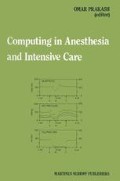Abstract
Automated real-time monitoring of the heart’s relative contractile state was achieved simply and cost effectively through automated analysis of the esophageal accelerogram (EA) and electrocardiogram (ECG). Previous work showed that the first major complex of the EA contains information which is a sensitive indicator of the left ventricle’s mechanical activity. An automated system was developed around a small, inexpensive, personal computer through the application of current software engineering design and implementation techniques. The resulting system has freed the physician from tedious, time consuming data analysis in the operating room. The ECG and EA analog signals are obtained from conventional physiologic monitors and processed by the system to yield an index of the relative contractile state every five seconds. This discrete index is trended along with heart rate (HR) by plotting the last twenty minutes of data. In addition, the most current numeric values of HR and the contractile index are presented. The system is contained on a single cart, and therefore, is easily rolled into the operating room (OR). Operation of the system was designed to be simple and unoccupying in the sometimes hectic environment of the operating room. System performance was tested and found to be accurate when supplied with correct analog signals. Electrocautery device generated electromagnetic interference of the ECG or EA caused the system to produce an appropriate error message and “hold” until an acceptable signal was obtained. Due to the minimally invasive nature of the esophageal probe, monitoring of the heart’s relative contractile state is performed on a routine basis with minimal risk to the patient.
Access this chapter
Tax calculation will be finalised at checkout
Purchases are for personal use only
Preview
Unable to display preview. Download preview PDF.
References
Broughton, A. and Korner, P.I. Estimation of maximum left ventricular inotropic response from changes in isovolumic indices of contractility in dogs. Cardio. Res., 15, pp. 382–389, 1981.
Diamond, G., et al. Mean electromechanicalΔp/Δt — An indirect index of the peak rate of rise of left ventricular pressure. Amer. J. Cardiol., 30, pp. 338–342, 1972.
Brubakk, O. and Foiling, M. Mean electromechanicalΔp/Δt and systolic time intervals in coronary artery disease. Europ. J. Cardiol., 7/5-6, pp. 367–377, 1978.
Van den Bos, G.C., et al. Problems in the use of indices of myocardial contractility. Cardio. Res., 7, pp. 834–848, 1973.
Weber, K.T., and Janicki, J.S. Instantaneous Force-Velocity-Length relations: Experimental findings and clinical correlates. Amer. J. Cardiol., 40, pp. 740–747, 1977.
Grossman, W., et al. Contractile State of the left ventricle in man as evaluated from end-systolic pressure-volume relations. Circulation, 56:5, pp. 845–852, 1977.
Lewis, R.P., et al. A Critical review of the systolic time intervals. Circulation, 56:2, pp. 146–158, 1977.
Folland, E.D., et al. Assessment of left ventricular ejection fraction and volumes by real-time, two dimensional echocardiography. Circulation, 60:4, pp. 760–766, 1979.
Pouleur, H., et al. Assesment of left ventricular contractility from late systolic stress — volume relations. Circulation, 65:6, pp. 1204–1212, 1982.
Divers, R.T., et al. Continuous real-time computation and display of systolic time intervals from surgical patients. Comput. Biomed. Res., 10, pp. 45, 1977.
Wiley, R.S., et al. A computerized system for monitoring systolic time intervals from esophageal accelerograms. Comput. Biomed. Res., 16, pp. 44–58, 1983.
Cahalan, M.K., et al. Intraoperative myocardial ischemia detected by transesopohageal 2-dimensional echocardiography — prognostic implications. In Proceedings of 5th annual meeting of Society of Cardiovascular Anesthesiologists., pp. 122, 1983.
Dauchot, P.S., et al. Detection of ischemia-induced left ventricular dyskinesia by the esophageal cardiokymogram in dogs. In Proceedings of 5th annual meeting of Society of Cardiovascular Anesthesiologists., pp. 126, 1983.
Wiley, R.S. and Shepard, L.S. Noninvasive monitoring of left ventricular contractile dynamics from esophageal accelerograms. In Proceedings of 5th annual meeting of Society of Cardiovascular Anesthesiologists., pp. 128, 1983.
Pinchak, A.C., et al. Esophageal accelerometer-Indicator of cardiovascular function. 3. Biomech. Eng., Trans. ASME 103, pp. 160–167, 1981.
Myers, G.J. “Composite/Structured Design.” Van Nostrand-Reinhold, New York, 1978.
Hughes, J.K. and Michtom, J.I. “A Structured Approach to Programming.” Prentice-Hall, Englewood Cliffs, N.J., 1977.
Author information
Authors and Affiliations
Editor information
Editors and Affiliations
Rights and permissions
Copyright information
© 1983 Martinus Nijhoff Publishers, Boston
About this chapter
Cite this chapter
Wiley, R.S., Shepard, L.S., Wolfenson, L.B. (1983). Automated Analysis of the Esophageal Accelerogram as a Minimally Invasive Monitor of Manifest Contractile State. In: Prakash, O. (eds) Computing in Anesthesia and Intensive Care. Developments in Critical Care Medicine and Anesthesiology, vol 5. Springer, Dordrecht. https://doi.org/10.1007/978-94-009-6747-2_8
Download citation
DOI: https://doi.org/10.1007/978-94-009-6747-2_8
Publisher Name: Springer, Dordrecht
Print ISBN: 978-94-009-6749-6
Online ISBN: 978-94-009-6747-2
eBook Packages: Springer Book Archive

